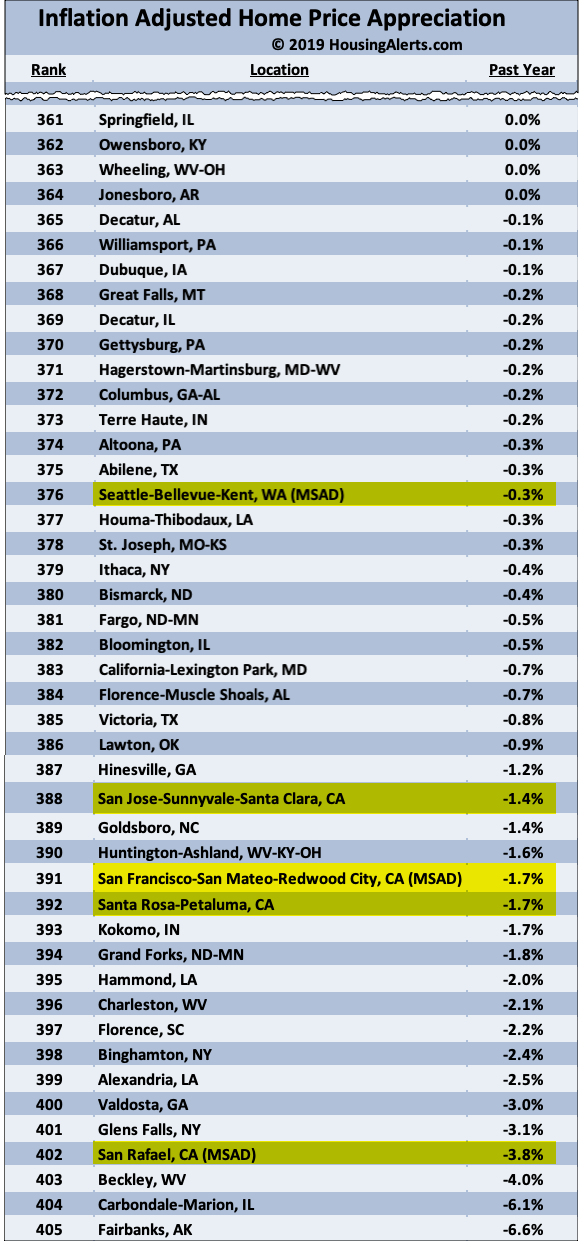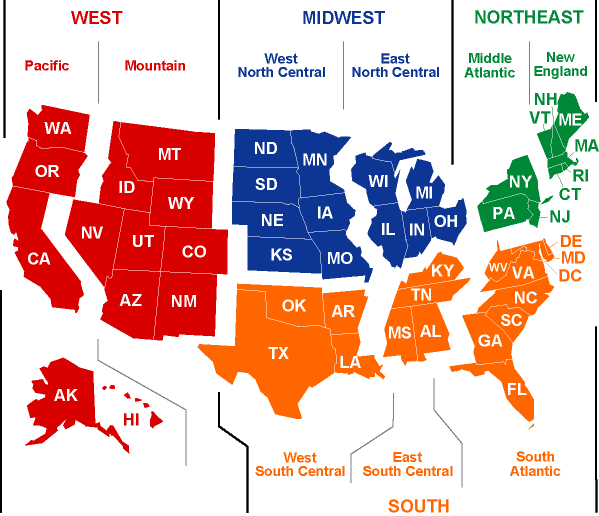Real Estate Strategy Blog
0
Published January 7, 2020

24% Of US Housing Markets Declined Qtr-Over-Qtr Currently, 98 markets (24% of all U.S. real estate) experienced ‘real’ (inflation adjusted) declines in property values compared to the prior Quarter. For the same period last year 104 markets (25%) saw Q-O-Q declines. Note: Because of seasonal variations between quarters, it’s best to compare Q-O-Q changes to […]
0
Published January 7, 2020

23 U.S. Markets Lost Value Year-Over-Year Currently, 23 markets (5% of ALL U.S. real estate) experienced ‘real’ (inflation adjusted) declines in property values over the last year. In the previous quarter, 45 markets had annual home price declines Although the number of declining markets is low by historical standards and remains at fairly healthy levels… […]
0
Published September 27, 2019

3 Steps to Finding Hottest Cash Flow Markets for Buying or Flipping High cash flow markets are typically weak or flat, with little or no likelihood for appreciation. (They generate higher cash flow BECAUSE they’ve not experienced a lot of appreciation over the years.) When a previously weak or dead real estate market starts a […]
0
Published September 19, 2019

17% Of US Housing Markets Declined Qtr-Over-Qtr Currently, 69 markets (17% of all U.S. real estate) experienced ‘real’ (inflation adjusted) declines in property values compared to the prior Quarter. For the same period last year 73 markets (18%) saw Q-O-Q declines. Note: Because of seasonal variations between quarters, it’s best to compare Q-O-Q changes to […]
0
Published September 3, 2019

45 U.S. Markets Lost Value Year-Over-Year Currently, 45 markets (11% of ALL U.S. real estate) experienced ‘real’ (inflation adjusted) declines in property values over the last year. In the previous quarter, 48 markets had annual home price declines Although the number of declining markets has not varied much over the last year or so, and […]
0
Published August 29, 2019

First Major U.S.Markets to Turn Negative Many real estate pundits have been pounding the table for years that the U.S. real estate market is on the verge of collapse. They were wrong then, and they’re wrong now. First off, there is no such thing as a “U.S. Real Estate Market.” You can only invest in […]
0
Published August 23, 2019

10 Best & Worst States for CASH FLOW With our new Cash Flow Finder tool, you can now identify the best and worst real estate markets for cash flow investing. Using the ‘Gross Rent Ratio’ (Median Annual Rent /Median Home Value) as a proxy for cash flow, you can see the 10 best and worst […]
0
Published August 1, 2019

We now track, analyze and score median rents paid for Single Family Residential (SFR) properties. We also compute the rental growth RATES for virtually all State, City, County and Zip Code level markets.
We then score and rank each market based on its rent growth and compare it to where it is in its appreciation cycle.
0
Published July 8, 2019

43% Of US Housing Markets Declined Qtr-Over-Qtr Currently, 175 markets (43% of all U.S. real estate) experienced ‘real’ (inflation adjusted) declines in property values compared to the prior Quarter. For the same period last year 146 markets (36%) saw Q-O-Q declines. Note: Because of seasonal variations between quarters, it’s best to compare Q-O-Q changes to […]
0
Published July 3, 2019

July 4, 1776 The Continental Congress declared that the thirteen American colonies were no longer subject to the monarch of Britain and were now united, free, and independent states.
0
Published June 26, 2019

Markets with the lowest priced properties are (almost) always the crummiest markets because they lack appreciation. Makes sense, right? If they were in hot, appreciating markets they wouldn’t be the cheapest for long! Here’s a list of the top 10 STATES, ranked by median house price.
0
Published June 13, 2019

48 U.S. Markets Lost Value Year-Over-Year Currently, 48 markets (12% of ALL U.S. real estate) experienced ‘real’ (inflation adjusted) declines in property values over the last year. In the previous quarter, 57 markets had annual home price declines (See the entire list of declining markets below.) In addition to the list of declining cities below, […]
































